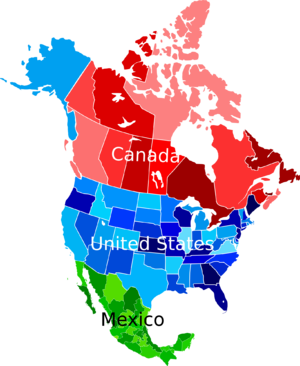Continental United States facts for kids
The contiguous United States means the 48 states that are all connected to each other, plus Washington, D.C., the nation's capital. These states are all located on the continent of North America.
This term does not include Alaska or Hawaii, because they are not physically connected to the other 48 states. It also doesn't include other U.S. lands like Puerto Rico or Guam, which are islands far away.
The distance across the 48 connected states, from Florida to Washington state, is about 2,802 miles (4,509 km). From north to south, it's about 1,650 miles (2,660 km).
The total area of the 48 contiguous states and Washington, D.C. is about 3,119,884 square miles (8,080,464 km2). This is a huge area, similar in size to Australia. Most of this area is land.
If you compare the contiguous U.S. to other countries, it would be the 5th largest in the world. However, the entire United States (including Alaska and Hawaii) is the 4th largest country. In 2010, almost all of the U.S. population lived in these 48 connected states.
Contents
Other Names for the Contiguous U.S.
People use different words to talk about the 48 connected states. Some words mean exactly the same thing, while others can be a bit confusing.
What is the Continental United States?
The term continental United States can sometimes be confusing. Since Alaska is also on the North American continent, this term could include Alaska. To avoid confusion, people sometimes say "continental U.S. excluding Alaska" or "continental U.S. including Alaska."
CONUS and OCONUS Explained
CONUS is a special term used by groups like the U.S. Department of Defense. It usually means the 48 connected states. OCONUS means "Outside Continental United States," referring to places like Alaska, Hawaii, or other U.S. territories.
The "Lower 48"
Many people, especially those in Alaska, use the term "Lower 48" to mean the contiguous United States. It's a common and easy way to refer to these states.
How Non-Connected States Talk About the Mainland
People living in Alaska and Hawaii have their own special ways to refer to the 48 connected states. This is because of their unique locations.
Alaska's View
Alaska became the 49th U.S. state in 1959. It's located far to the northwest of the other states, separated by Canada. In Alaska, people often say "Lower 48" or "Outside" when they talk about the rest of the United States. "Outside" can even mean any place not in Alaska.
Hawaii's View
Hawaii became the 50th U.S. state in 1959. It's a group of islands in the Pacific Ocean, about 2,200 miles (3,500 km) from North America. Because Hawaii is so far away, people there often use the terms the Mainland or U.S. Mainland to refer to the contiguous United States.
Places Not Connected by Road
Even within the contiguous United States, there are a few small areas that you can only reach by driving through Canada. These include Point Roberts, Washington, Elm Point, Minnesota, and the Northwest Angle in Minnesota.
List of the 48 Contiguous U.S. States
Here are the 48 states that are all connected:
Remember, Washington, D.C. is the capital city and is separate from the state of Washington.


